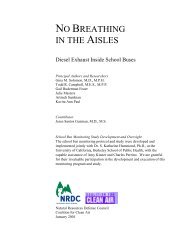p.53-94 (pdf) - Natural Resources Defense Council
p.53-94 (pdf) - Natural Resources Defense Council
p.53-94 (pdf) - Natural Resources Defense Council
You also want an ePaper? Increase the reach of your titles
YUMPU automatically turns print PDFs into web optimized ePapers that Google loves.
Appendix C U.S. Nuclear Weapons, Location Profiles, CONTINUED<br />
GEORGIA<br />
Rank: No. 2<br />
Nuclear Warheads: 2000<br />
Kings Bay<br />
NAVAL SUBMARINE BASE<br />
GEORGIA ranks 2nd in number of nuclear warheads deployed, a<br />
rise from 11th place in 1992, and 12th place in 1985. The Naval<br />
Submarine Base Kings Bay is the homeport for the Navy’s Atlantic-based<br />
Trident II-equipped (Ohio class) ballistic missile submarine<br />
force subordinate to the Submarine Forces Atlantic Fleet<br />
(SUBLANT). The base is just north of the Florida-Georgia border,<br />
about 40 miles north of Jacksonville, Florida.<br />
The W88 and W76 warheads for the ten assigned submarines<br />
are nominally “stored” at the base, even though half of those submarines<br />
are at sea (or in overhaul) at any one time. The Strategic<br />
Weapons Facility Atlantic (SWFLANT) is responsible for storage,<br />
handling, and maintenance of nuclear weapons at Kings Bay. Because<br />
the number of W88 Trident II warheads manufactured was<br />
not sufficient to arm all ten of the Trident II capable submarines,<br />
W76 Trident I warheads from retired Atlantic fleet Poseidon submarines<br />
also arm the force.<br />
The Army began to acquire land at Kings Bay in 1954 on which<br />
it planned to build a military ocean terminal which would be used<br />
to ship ammunition in event of a national emergency. Construction began in 1956 and was completed<br />
two years later at a cost of $11 million. The most prominent feature of the terminal was a 2000 footlong,<br />
87 foot-wide concrete and steel wharf, with three parallel railroad tracks, enabling simultaneous<br />
loading of several ammunition ships. A 10 mile-long, 200 foot-wide channel, dredged by the<br />
Army to 32 feet provided access between the bay and the ocean via the St. Marys channel. Elsewhere<br />
the Army built 47 miles of railroad track. The base was never activated.<br />
In 1975 there were negotiations between the U.S. and Spain over the continued basing of ballistic<br />
missile submarines at Rota, Spain. The resulting 1976 treaty called for withdrawal of the Navy<br />
squadron by July 1979. Some sixty sites along the Atlantic and Gulf coasts were evaluated as a<br />
replacement and by the summer of 1976 the number was reduced to five: Narragansett Bay, RI;<br />
Cheatham Annex, VA; Charleston, SC; Mosquito Lagoon, FL; and Kings Bay, GA. Kings Bay was<br />
chosen to be the support base for Squadron Sixteen in November 1976, with initial homeporting of<br />
the submarines and crews in Charleston, SC. The relocation occured in July 1979 with a submarine<br />
tender (USS Canopus, AS-34), a floating dry dock (USS Oak Ridge, ARDM-1), and eight SSBNs. This<br />
modest four year effort cost $125 million.<br />
In May 1979 Kings Bay was selected as the permanent east coast Trident homeport, refit site,<br />
and training base for Ohio-class SSBNs. This major decade-long effort cost several billion dollars.<br />
On March 29, 1990 the Navy declared the USS Tennessee (SSBN 734) operational as it went on its<br />
first patrol from Kings Bay, carrying Trident II SLBMs. On September 6, 1997 the 18th and last Ohioclass<br />
submarine (the USS Louisiana) was commissioned, the tenth to be based at Kings Bay.<br />
58 TAKING STOCK
















